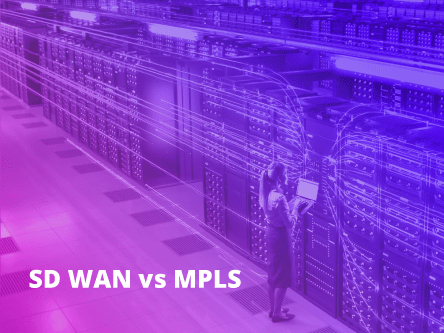Why a unified Secure Access Service Edge (SASE) cloud network is the ideal future-proof security and connectivity solution for all companies with a multi-cloud strategy.
Hybrid and Multi-Cloud Are Exerting Significant Pressure on Existing Firewalls and Networks
For many years, companies have been focusing on securing their central enterprise data centre. They often relied on traditional network firewalls to authenticate and secure employee connections. However, the landscape has evolved dramatically. The advent of remote working, the proliferation of hybrid work models, and the widespread adoption of cloud-based applications have introduced a new era of complex networking. As an IT manager, how do you ensure that your users can connect safely and quickly to all those different cloud applications from any location?
During our recent event, ‘’Achieving Edge-to-Cloud Security Excellence’’, in collaboration with HPE Aruba Networking, we addressed 4 critical network challenges in today’s evolving digital world. We explored how implementing an end-to-end SASE overlaid with connectivity can help businesses to effectively enhance security and accelerate their network traffic.
4 Business Challenges A Unified SASE Cloud Network Solves to Keep Data Fast and Secure
1. The challenge: Securely connect business locations to any application
One of the foremost challenges facing organisations today is providing their employees with fast and secure access to business applications, regardless of their location. Traditionally, branch offices and remote workers would establish connections through the central enterprise data centre, which acted as a gateway to the cloud applications. However, this approach gives rise to two common problems.
- Firstly, this creates delay (latency) because the traffic must follow an illogical route to the enterprise data centre before reaching the cloud application via another longer route.
- Secondly, this traffic places considerable strain on the central enterprise firewall, creating an ongoing challenge for IT managers. They constantly have to create extra rules for new employees, devices, and applications.
The solution: Automatic local aggregation, validation, and routing
A unified SASE cloud network solves this problem by aggregating the traffic through the nearest edge node. Through the local SASE Edge Points of Presence (cloud and network node), the traffic is automatically validated and routed to the local data centre or a public cloud provider. As an IT manager, you prevent traffic from accumulating unnecessarily in your company network. You can be sure that the traffic is always optimally secured by SASE cloud networking services.
2. The challenge: Securely connect remote employees to any cloud application
Your IT team faces the high expectations of providing your colleagues with a well-functioning and secure connection to their preferred cloud applications. For years, Multiprotocol Label Switching (MPLS) was the ideal solution to connect to the enterprise data centre from anywhere. However, this conventional approach to remote work no longer aligns with today’s dynamic landscape, and there are three compelling reasons for this shift.
- Device security: Employees nowadays connect to the enterprise data centre and cloud applications via many different devices, connections and browsers. To physically secure, manage and operate all these devices is almost impossible.
- Cloud applications: The enterprise data centre and network are no longer centralised, as employees now need to connect to decentralised applications residing in various public clouds environment.
- Scalability: Traditional MPLS networks are less flexible and not immediately scalable both up- and down.
The solution: Global SASE cloud networking entry points and local firewall authentication
With Unified SASE solutions, these network limitations of MPLS have been solved.
- Your colleagues can now automatically connect to the nearest SASE cloud network Point of Presence (PoP), via built-in secure clients in their devices or in a browser.
- The global SASE cloud network optimises the traffic of your colleagues and sends it to the business applications via the best and fastest route available.
- The worldwide SASE cloud network is automatically scalable, so that you as an end user never suffer from latency. As an IT manager, you will no longer be surprised by flooded network ports.
3. The challenge: Connect businesses worldwide to new cloud applications – fast and secure
With many companies choosing to implement a multi-cloud strategy, both the role of the enterprise data centre and the MPLS network are changing. After all, the MPLS network had one function: To establish a central secure connection to applications in the data centre. However, with a growing number of applications now residing in external public clouds, the need to route all traffic through the enterprise data centre has been eliminated. The demand for flexible and scalable connections is increasing.
The solution: SASE moves flexibly with your dynamic cloud strategy
Unified SASE cloud networks are therefore the ideal solution for companies that want to remain flexible, without having to constantly revise the network design. Businesses can quickly implement a multi-cloud strategy, and easily adjust or switch back to hybrid or single private cloud as needed. The SASE cloud network is automatically scaled and adjusted based on your usage and choices which is a lot more flexible than a static MPLS network.
4. The challenge: Securely and quickly connect to multi-cloud services and enterprise data centres simultaneously
Many companies are experimenting with web application firewalls to secure the edge locations of the corporate network. As a result, they have to configure different web application firewalls for each cloud provider and optimise them for access to the enterprise data centre. This creates another problem, as each web application firewall provider has its own routing and protocols for connecting to public cloud providers.
The solution: Built-in private network links with public cloud providers
A unified SASE cloud network eliminates the need to configure additional firewalls, relieving users from the need for manual setup. Users establish connections over the public Internet to the nearest SASE PoP location through a secure tunnel. From there, the traffic is sent in a closed network via the fastest route to the desired cloud provider. SASE users benefit from the advantage of pre-existing direct links to major cloud providers like AWS, Azure, or Google Cloud. This eliminates the need for expensive separate connectivity services such as ExpressRoute or Direct Connect.
Contact Epsilon to Learn More About Next-generation Enterprise Networks
The unified SASE solution provided by Epsilon, partnered with HPE Aruba Networking, enables next-generation future proof enterprise networks. With SASE, your colleagues and IT organisation remain flexible, no matter how your private, hybrid or multi-cloud strategy changes in the future. HPE Aruba’s unified SASE platform and Epsilon’s global network of 300 PoPs form the best scalable enterprise network combination. Contact Epsilon to learn more about our solution with HPE Aruba Networking and how we can help you secure, scale and transform your enterprise network.







